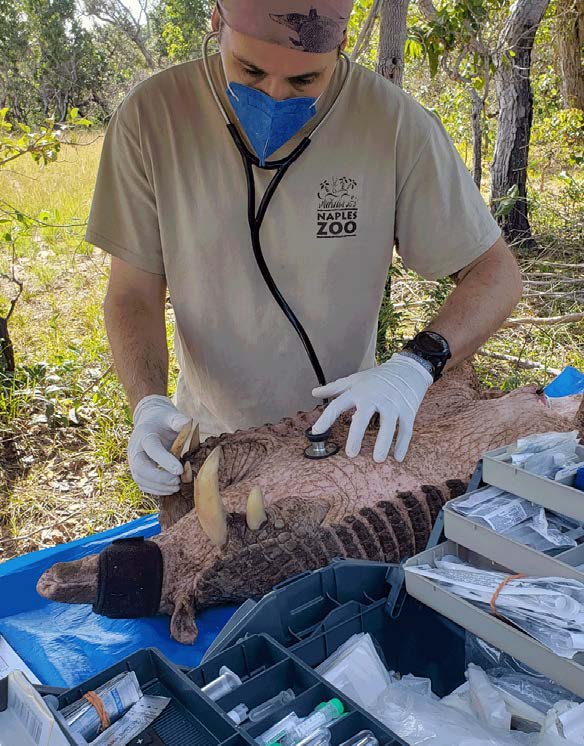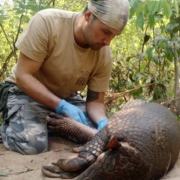The Giant Armadillo Conservation Program Receives Top Honor from AZA
 The Giant Armadillo Conservation Program (GACP), a collaboration between Naples Zoo, Houston Zoo, and SeaWorld Parks and Entertainment, recently received the William G. Conway International Conservation Award from the Association of Zoos and Aquariums (AZA). The award recognizes exceptional efforts by AZA Institutions, Related Facilities or Conservation Partner members toward habitat preservation, species restoration, and support of biodiversity in the wild. The AZA is the accrediting body for the top zoos and aquariums in the United States and 12 other countries.
The Giant Armadillo Conservation Program (GACP), a collaboration between Naples Zoo, Houston Zoo, and SeaWorld Parks and Entertainment, recently received the William G. Conway International Conservation Award from the Association of Zoos and Aquariums (AZA). The award recognizes exceptional efforts by AZA Institutions, Related Facilities or Conservation Partner members toward habitat preservation, species restoration, and support of biodiversity in the wild. The AZA is the accrediting body for the top zoos and aquariums in the United States and 12 other countries.
“There has never been a time when conservation matters more, as many species are disappearing at an alarming rate. The commitment and collaboration of these well-respected zoological organizations – Houston and Naples Zoos and SeaWorld — to understand and protect the giant armadillo, a species so little is known about, is extraordinary. If not for their work, sadly the giant armadillo would be lost forever,” AZA President and CEO, Dan Ashe, said.
The giant armadillo is the largest armadillo species in the world, with a wide distribution throughout South American habitats. They are rare throughout their range, experiencing local extinctions in Uruguay and elsewhere. While habitat destruction, poisoning, and hunting pose major threats to remaining populations, much about this species remains unknown. The species has been deemed vulnerable to extinction by the International Union for Conservation of Nature. Giant armadillos were declared one of five indicator species for the creation of protected areas in 2014 thanks to the GACP efforts.
 Wildlife doesn’t stop at the borders of protected areas, so neither can conservation,” Tim Tetzlaff, Naples Zoo’s Director of Conservation, said.
Wildlife doesn’t stop at the borders of protected areas, so neither can conservation,” Tim Tetzlaff, Naples Zoo’s Director of Conservation, said.
“Large rural landowners can support tremendous amounts of wildlife on their private lands. Understanding their perspective and truly collaborating with these key stakeholders is critical for wildlife species to remain abundant enough to fill their place in the ecosystem, including giant armadillos’ role in aiding dozens of other rare species. Naples Zoo greatly values the GACP’s efforts in listening to diverse audiences to address the needs of people, animals, and the land – a pattern we follow in regional work with Florida panthers.”
GACP First to Identify the Giant Armadillo as an Ecosystem Engineer.
In 2011, GACP established the first long-term ecological study of giant armadillos in Brazil. It was the first to identify the species as ecosystem engineers. Empty giant armadillo burrows become a shelter from predators and temperature extremes for over 70 species of wildlife from lizards and snakes to ocelots, peccaries, and anteaters. GACP is pioneering methodologies to investigate giant armadillo ecology and biology, promoting conservation awareness through environmental education and outreach, and has become one of the leading capacity-building projects for aspiring conservationists with over 85 Brazilian biologists and veterinarians trained since its inception. Its goal continues to be to use field data to inform conservation outreach and planning and make giant armadillos a flagship species for biodiversity conservation to safeguard remaining native habitats and wildlife.
 “Without the support of AZA zoos, we would never have been able to start or continue the Giant Armadillo Conservation Program,” Dr. Arnaud Desbiez, head of the Giant Armadillo project, said. “Even though there are no giant armadillos in AZA collections, zoos have worked together to fund, create new field techniques, build the capacity of the team and create such a strong partnership that our collective effort now spans four biomes and six conservation initiatives”.
“Without the support of AZA zoos, we would never have been able to start or continue the Giant Armadillo Conservation Program,” Dr. Arnaud Desbiez, head of the Giant Armadillo project, said. “Even though there are no giant armadillos in AZA collections, zoos have worked together to fund, create new field techniques, build the capacity of the team and create such a strong partnership that our collective effort now spans four biomes and six conservation initiatives”.
Education programs at all three institutions highlight the project to guests in both programming and interpretative messaging.



Leave a Reply
Want to join the discussion?Feel free to contribute!